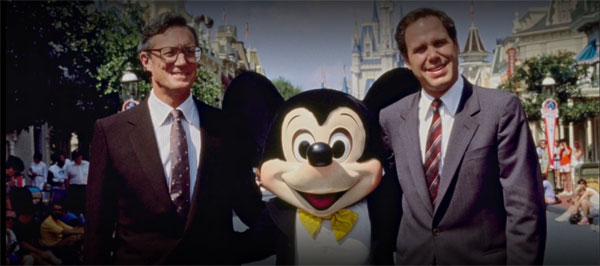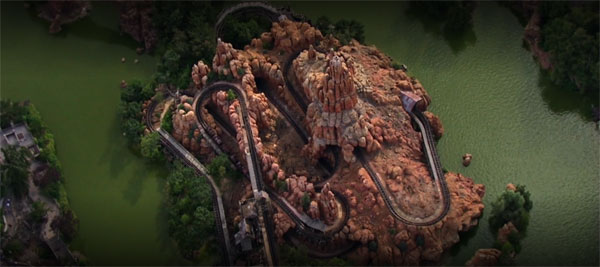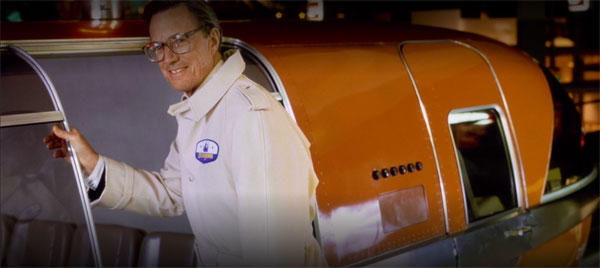
Michael Eisner takes center stage on Episode 3 of The Imagineering Story, but the star is Imagineer Tony Baxter. He receives more screen time with the focus on classics like Big Thunder Mountain Railroad, Splash Mountain, and the Indiana Jones Adventure, plus Disneyland Paris. Baxter is a master at describing themed design in a way that is easy for anyone to understand. His personal story as a Disneyland enthusiast who became an Imagineer also fits with the inspiring side of this tale.
Baxter’s work signifies the expansion of the parks, especially after Eisner’s arrival in 1984. A scene with Baxter excitedly getting ice cream reminds us of his fandom, which remains strong. If you haven’t listened to them, the episodes of The Season Pass Podcast with Baxter do an amazing job telling his story. Other footage with him walking through Indiana Jones helps to explain why that attraction shined. His down-to-earth demeanor on camera makes him the perfect subject for Leslie Iwerks’ series.
I’m relieved to see that Eisner was willing to participate in this documentary, which won’t shy away from mistakes. “The Midas Touch” largely focuses on the exciting time following the arrival of Eisner and Frank Wells. They took a struggling company, especially with its movies, and helped shape the framework for the Disney we know today. Eisner explains how Disney “lacked contemporary development”, and that view led to deals with Michael Jackson and George Lucas. Star Tours in particular created a model for successful attractions under Eisner.

Shock to the System
This episode’s momentum matches the atmosphere at Imagineering during the early days of Eisner and Wells. Tom K. Morris describes the push to make things excellent under the leaders. Unlike today, the parks still drove the revenues for Disney, so upgrading them was essential. They weren’t just one arm of a massive segment of the company focused on “consumer products“.
Narrator Angela Bassett describes the hits quickly as we move through Star Tours, the Disney/MGM Studios, and Splash Mountain. There is a brief mention of the controversial source material for the log flume. I would have enjoyed more back story about the decision. Karina Longworth has discussed the choice on the amazing season of the You Must Remember This podcast about Song of the South. There is a lot to cover, so the omission is understandable.
Baxter aptly describes the different elements that make up a successful theme park attraction – reality, thrills, and emotional appeal. He also explains how he designs for the 20th ride, not the first. This type of design was everywhere at that time, and The Great Movie Ride and Twilight Zone Tower of Terror are prime examples. You can sense the excitement from the Imagineers as they recount that era. Eisner deserves credit for saving Disney and Imagineering.
This episode spotlights the importance of Frank Wells, who would grab the best ideas. He provided a check on Eisner that helped to ensure the success of “The Disney Decade”. Eisner thought big, and that approach only works if someone like Wells is on board. The clip from Wells’ memorial after his tragic death in 1994 shows the impact of the loss on Eisner. The Imagineers lost their champion, and the initial optimism and creativity would not last.

Disney’s Most Beautiful Theme Park
The centerpiece of “The Midas Touch” is Disneyland Paris, designed to be the crown jewel of Disney’s theme parks. Baxter joined talented young Imagineers like Morris, Eddie Sotto, and Tim Delaney to create a striking park. I visited Paris in 2006 and was blown away by the details and different takes on attractions. Morris designed the Sleeping Beauty Castle, which stands apart from the others. He explains its style in this episode, along with Katie Olson, and both do an excellent job describing it.
The clips from Disneyland Paris remind me of its beauty, which feels European while retaining aspects of Disney. Big Thunder Mountain Railroad in Paris is the best version, and Space Mountain lifted the technology to greater heights. An interview with Delaney from 1997 describes the first catapult launch for Space Mountain; it’s too bad that Delaney wasn’t involved directly in this show. He had a lot of interesting things to say about Discoveryland when I talked to him on the podcast.
Despite the design successes in Paris, obstacles arose along the way. I loved the footage of Eisner getting pelted with eggs by angry French residents. I’d forgotten that even happened, and his reaction is priceless. Paris wasn’t a hit at the start due to a variety of reasons. Eisner cites too many hotel rooms, which was a big factor, and Bruce Vaughn questions whether Disney just spent too much. I’m glad that Disneyland Paris exists, though its struggles made Eisner hesitant with future projects. You can draw a direct line between the challenges in Paris to the budget limitations for the original version of Disney California Adventure.

The End of Theme Parks?
The final moments of “The Midas Touch” introduce the start of a different era for Disney, and it’s not a pretty one. Morris describes the slashing of budgets and the idea that “theming was a bad word”. The focus on spreadsheets over creative concerns as explained by Vaughn sets the scene for big challenges. Imagineering had thrived under Eisner and built incredible attractions, but trouble was on the horizon. It’s a captivating way to end the first half of The Imagineering Story. I’ve loved the series so far and can’t wait for the next steps.



Leave a Reply